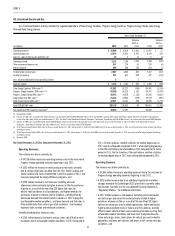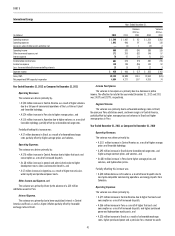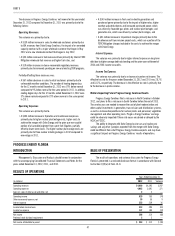Duke Energy 2012 Annual Report Download - page 61
Download and view the complete annual report
Please find page 61 of the 2012 Duke Energy annual report below. You can navigate through the pages in the report by either clicking on the pages listed below, or by using the keyword search tool below to find specific information within the annual report.-
 1
1 -
 2
2 -
 3
3 -
 4
4 -
 5
5 -
 6
6 -
 7
7 -
 8
8 -
 9
9 -
 10
10 -
 11
11 -
 12
12 -
 13
13 -
 14
14 -
 15
15 -
 16
16 -
 17
17 -
 18
18 -
 19
19 -
 20
20 -
 21
21 -
 22
22 -
 23
23 -
 24
24 -
 25
25 -
 26
26 -
 27
27 -
 28
28 -
 29
29 -
 30
30 -
 31
31 -
 32
32 -
 33
33 -
 34
34 -
 35
35 -
 36
36 -
 37
37 -
 38
38 -
 39
39 -
 40
40 -
 41
41 -
 42
42 -
 43
43 -
 44
44 -
 45
45 -
 46
46 -
 47
47 -
 48
48 -
 49
49 -
 50
50 -
 51
51 -
 52
52 -
 53
53 -
 54
54 -
 55
55 -
 56
56 -
 57
57 -
 58
58 -
 59
59 -
 60
60 -
 61
61 -
 62
62 -
 63
63 -
 64
64 -
 65
65 -
 66
66 -
 67
67 -
 68
68 -
 69
69 -
 70
70 -
 71
71 -
 72
72 -
 73
73 -
 74
74 -
 75
75 -
 76
76 -
 77
77 -
 78
78 -
 79
79 -
 80
80 -
 81
81 -
 82
82 -
 83
83 -
 84
84 -
 85
85 -
 86
86 -
 87
87 -
 88
88 -
 89
89 -
 90
90 -
 91
91 -
 92
92 -
 93
93 -
 94
94 -
 95
95 -
 96
96 -
 97
97 -
 98
98 -
 99
99 -
 100
100 -
 101
101 -
 102
102 -
 103
103 -
 104
104 -
 105
105 -
 106
106 -
 107
107 -
 108
108 -
 109
109 -
 110
110 -
 111
111 -
 112
112 -
 113
113 -
 114
114 -
 115
115 -
 116
116 -
 117
117 -
 118
118 -
 119
119 -
 120
120 -
 121
121 -
 122
122 -
 123
123 -
 124
124 -
 125
125 -
 126
126 -
 127
127 -
 128
128 -
 129
129 -
 130
130 -
 131
131 -
 132
132 -
 133
133 -
 134
134 -
 135
135 -
 136
136 -
 137
137 -
 138
138 -
 139
139 -
 140
140 -
 141
141 -
 142
142 -
 143
143 -
 144
144 -
 145
145 -
 146
146 -
 147
147 -
 148
148 -
 149
149 -
 150
150 -
 151
151 -
 152
152 -
 153
153 -
 154
154 -
 155
155 -
 156
156 -
 157
157 -
 158
158 -
 159
159 -
 160
160 -
 161
161 -
 162
162 -
 163
163 -
 164
164 -
 165
165 -
 166
166 -
 167
167 -
 168
168 -
 169
169 -
 170
170 -
 171
171 -
 172
172 -
 173
173 -
 174
174 -
 175
175 -
 176
176 -
 177
177 -
 178
178 -
 179
179 -
 180
180 -
 181
181 -
 182
182 -
 183
183 -
 184
184 -
 185
185 -
 186
186 -
 187
187 -
 188
188 -
 189
189 -
 190
190 -
 191
191 -
 192
192 -
 193
193 -
 194
194 -
 195
195 -
 196
196 -
 197
197 -
 198
198 -
 199
199 -
 200
200 -
 201
201 -
 202
202 -
 203
203 -
 204
204 -
 205
205 -
 206
206 -
 207
207 -
 208
208 -
 209
209 -
 210
210 -
 211
211 -
 212
212 -
 213
213 -
 214
214 -
 215
215 -
 216
216 -
 217
217 -
 218
218 -
 219
219 -
 220
220 -
 221
221 -
 222
222 -
 223
223 -
 224
224 -
 225
225 -
 226
226 -
 227
227 -
 228
228 -
 229
229 -
 230
230 -
 231
231 -
 232
232 -
 233
233 -
 234
234 -
 235
235 -
 236
236 -
 237
237 -
 238
238 -
 239
239 -
 240
240 -
 241
241 -
 242
242 -
 243
243 -
 244
244 -
 245
245 -
 246
246 -
 247
247 -
 248
248 -
 249
249 -
 250
250 -
 251
251 -
 252
252 -
 253
253 -
 254
254 -
 255
255 -
 256
256 -
 257
257 -
 258
258 -
 259
259 -
 260
260 -
 261
261 -
 262
262 -
 263
263 -
 264
264 -
 265
265 -
 266
266 -
 267
267 -
 268
268 -
 269
269 -
 270
270 -
 271
271 -
 272
272 -
 273
273 -
 274
274 -
 275
275 -
 276
276 -
 277
277 -
 278
278 -
 279
279 -
 280
280 -
 281
281 -
 282
282 -
 283
283 -
 284
284 -
 285
285 -
 286
286 -
 287
287 -
 288
288 -
 289
289 -
 290
290 -
 291
291 -
 292
292 -
 293
293 -
 294
294 -
 295
295 -
 296
296 -
 297
297 -
 298
298 -
 299
299 -
 300
300 -
 301
301 -
 302
302 -
 303
303 -
 304
304 -
 305
305 -
 306
306 -
 307
307 -
 308
308
 |
 |

41
PART II
International Energy
Years Ended December 31,
(in millions) 2012 2011
Variance
2012 vs.
2011 2010
Variance
2011 vs.
2010
Operating revenues $ 1,549 $ 1,467 $ 82 $ 1,204 $ 263
Operating expenses 1,043 946 97 816 130
Losses on sales of other assets and other, net —(1) 1 (3) 2
Operating income 506 520 (14) 385 135
Other income and expense, net 171 203 (32) 146 57
Interest expense 76 47 29 71 (24)
Income before income taxes 601 676 (75) 460 216
Income tax expense 149 195 (46) 143 52
Less: Income attributable to noncontrolling interests 13 15 (2) 12 3
Segment income $ 439 $ 466 $ (27) $ 305 $ 161
Sales, GWh 20,132 18,889 1,243 19,504 (615)
Net proportional MW capacity in operation 4,584 4,277 307 4,203 74
Year Ended December 31, 2012 as Compared to December 31, 2011
Operating Revenues.
The variance was driven primarily by:
• A $53 million increase in Central America as a result of higher volumes
due to a full year of commercial operations of the Las Palmas II plant
and favorable hydrology,
• A $24 million increase in Peru due to higher average prices, and
• A $10 million increase in Argentina due to higher volumes as a result of
favorable hydrology, partially offset by unfavorable exchange rates.
Partially offsetting this increase was:
• A $7 million decrease in Brazil as a result of unfavorable exchange
rates partially offset by higher average prices and volumes.
Operating Expenses.
The variance was driven primarily by:
• A $76 million increase in Central America due to higher fuel costs and
consumption as a result of increased dispatch,
• An $8 million increase in general and administrative due to higher
development costs, labor, and executive benefi ts, and
• A $7 million increase in Argentina as a result of higher transmission,
water royalty and purchased power costs.
Other Income and Expense, net.
The variance was primarily driven by the absence of a $20 million
arbitration award in Peru.
Interest Expense.
The variance was primarily due to lower capitalized interest in Central
America and Brazil, as well as higher infl ation partially offset by favorable
exchange rates in Brazil.
Income Tax Expense.
The variance in tax expense is primarily due to a decrease in pretax
income. The effective tax rate for the year ended December 31, 2012 and 2011
was 24.8% and 28.9%, respectively.
Segment Income.
The variance was primarily due to unfavorable exchange rates in Brazil,
the prior year Peru arbitration award, and lower margins in Central America,
partially offset by higher average prices and volumes in Brazil and higher
average prices in Peru.
Year Ended December 31, 2011 as Compared to December 31, 2010
Operating Revenues.
The variance was driven primarily by:
• A $111 million increase in Central America as a result of higher average
prices and favorable hydrology,
• A $95 million increase in Brazil due to favorable exchange rates, and
higher average contract prices and volumes, and
• An $80 million increase in Peru due to higher average prices and
volumes, and hydrocarbon prices.
Partially offsetting this increase was:
• A $25 million decrease in Ecuador as a result of lower dispatch due to
new hydro competitor commencing operations and energy imports from
Colombia.
Operating Expenses.
The variance was driven primarily by:
• A $77 million increase in Central America due to higher fuel costs and
consumption as a result of increased dispatch,
• A $56 million increase in Peru as a result of higher fuel costs and
consumption as a result of increased dispatch, and higher purchased
power and hydrocarbon royalty costs, and
• A $25 million increase in Brazil as a result of unfavorable exchange
rates, higher purchased power and a provision for a revenue tax audit.
